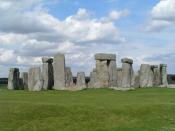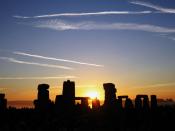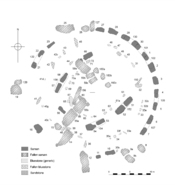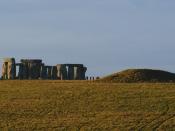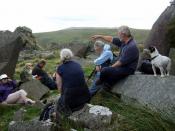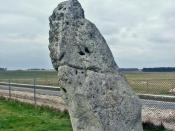Stonehenge: a megalithic monument that has survived for over five millennium; one of the worldÃÂs manmade wonders; a source of eternal speculation and mysteries for over a thousand yearsÃÂ and the cause of much squabbling amongst experts over the answers.
Too many unknowns to make any definite conclusions, to this day, Stonehenge remains one of the great mysteries of the Earth. Located on the downlands of the Salisbury Plain in southern England, the ruins of Stonehenge consist now of a hundred and sixty-two stones of up to 40 tonnes in mass painstakingly arranged to recognize the summer and winter solstices. Two main types of stone were used in the construction. The large pillars that form the outer circle are sarsen, a local sandstone that is believed to have come from the Marlborough Downs 30 kilometres north of Stonehenge. The smaller Stonehenge stones are bluestones, averaging 4 tonnes, forming the two inner circles, and completely foreign to southern England.
Perhaps this is the most heated debate over the ancient stone circleÃÂthe bluestone mystery. While centuries of speculation and detailed petrographic studies can trace the stones back to the rocky outcroppings of Carn Menyn, located in the Preseli Hills of southwest Wales, about 250 kilometres from Stonehenge, and over 400 by land, the real question remains: if they were in Wales, how did they come to Salisbury? The earliest recorded theory dates back to around 1139AD, when Geoffrey of Monmouth wrote:"If you are desirous," said Merlin, "to honour the burying place of these men with an everlasting monument, send for the Giant's Dance, which is in Killaraus, a mountain in Ireland. For there is a structure of stones there, which none of this age could raise, without a profound knowledge of the mechanical arts. They are stones of a vast magnitude and wonderful quality; and if they can be placed here, as they are there, round this spot of ground, they will stand forever."-History of the Kings of Britain by Geoffrey of Monmouth, pp133+In Geoffrey of MonmouthÃÂs tale, Merlin magics the stones into boats to be transported back to England, and then sets up the stones as Stonehenge. Oddly enough, in the early historianÃÂs time the Preseli Mountains lay in an area settled by the Irish, and was sometimes referred to as Ireland. So Geoffrey of Monmouth may have been, knowingly or not, right about their location. If so, does the method of transportation (minus the magic) hold some element of truth too? After all, by the 12th century AD Stonehenge had existedÃÂcompleteÃÂfor more than two thousand years.
It wasnÃÂt until 1908, when geologist Herbert Thomas suggested that the Stonehenge bluestones matched those in the Preseli Hills of southwest Wales, that the idea was taken seriously, and in 1921, he theorized that the Neolithic Britons quarried the bluestones in Wales, then carried them back to England by human labour. The theory of human transport went largely unquestioned, until 1971, when another geologist, Geoffrey Kellaway, dismissed ThomasÃÂ ÃÂheroic bluestone enterpriseÃÂ as impossible and introduced the concept of the stones being carried to England by glacial movement. As evidence, he pointed out glacial deposits nearbyÃÂon Near Street, only 60km from Stonehenge, and Bath, a mere 40km.
Today, with advanced technology and dating equipment to further hone the evidence, archaeologists, historians and geologists continue this debate. Despite being the initially more preposterous theory, the evidence behind glacial movement has stacked up, and is currently in the lead. Dr Brian John, the author of several articles dedicated to the debate, an expert on ice and glaciers, is currently the most vocal supporter of the glacial movement theory. His argument relies heavily on recently reconstructed flow patterns of the ice sheets in Britain. From the arrows, it does seem plausibleÃÂeven likelyÃÂthat there was glacial movement in the Salisbury Plains, and that this glacial movement carried the bluestones into the region. However, this is not conclusive evidence.
Dr Brian John also pointed out the multitude of rock types found in the areaÃÂnot all local. From this, it follows to reason that the people who built Stonehenge were simply using the most convenient and suitable stones in the area, not traversing hundreds of kilometres to drag back giant slabs of stone. The bluestones, when investigated with modern geochemistry, prove to come from all over southern Wales, not one designated spot for quarrying. And the bluestones are not the only foreign rocks in the ancient monument: the Altar Stone, in the heart of the stone circle, belongs to the Senni Beds of the Old Red Sandstone formation, which outcrops in many parts of West and South Wales. Furthermore, diabase fragments from several archaeological digs far older than Stonehenge have also been uncovered, suggesting that the bluestones had been in the area long before construction began.
However, Professor Geoffrey Wainwright, archaeology expert and formerly chief archaeologist at English Heritage, is as convinced a supporter of the human transport theory. From an excavation he carried out in 2008 along with Professor Tim Darvill, he connects an array of shrewd clues and corpses in tombs nearby to conclude that bluestone was believed to have magical healing powers, and that Stonehenge was built as a centre of healing. An abnormal number of these corpses had marks of physical injury or disease, and dental analyses indicate that around half were not native to the area. Also, small chippings of bluestoneÃÂthree times as many as of the sarsenÃÂare believed to have been talismans, kept as lucky charms and perceived as valuable. WainwrightÃÂs theory is that the ÃÂmagicalÃÂ bluestones were brought over from Wales specifically to build a ÃÂNeolithic LourdesÃÂ. "Their meaning and importance to prehistoric people was sufficiently powerful to warrant the investment of time, effort and resources to move the bluestones from the Preseli Hills of Wales to the Wessex downs." Professor Darvill commented on the bluestones.
From a radiocarbon date determined during the excavation, the original bluestones were erected in 2300BC, which has raised questions about a connection with the ÃÂAmesbury ArcherÃÂ, of whose burial date coincides. The Archer was discovered several kilometres from Stonehenge, and analyses of his corpse and artefacts from his grave suggest he was a rich, powerful man, suffering a severe knee injury and dental disease, and had travelled from Alpine Europe to Salisbury. Wainwright is convinced he came for healing, although it is still unclear if Stonehenge had existed while he was alive. Another find at the dig and another radiocarbon date suggests that the Stonehenge site was inhabited from as long ago as 7200BC. WainwrightÃÂs view on the glacial movement theory is absolute: "The one tiny flaw in the theory is that there is absolutely no evidence for glaciation of Wiltshire," Wainwright said.
Neither is conclusive, however. Wainwright and DarvillÃÂs theory is rooted in speculation, not facts. Stonehenge may very well have been a place of healing without requiring such a mammoth effort to build. The issue raised about human transport is the physical possibility of it. In 2000, an attempt to prove the human transport theory was still valid, Philip Bowen organized the Millenium Stone Project, in which the community in Pembrokeshire attempted to transport a three tonne bluestone (fondly nicknamed ÃÂElvis PreseliÃÂ) 240 miles over land, river and sea to Stonehenge, using techniques the Neolithic Britons might have used. Needless to say, it was an unmitigated disaster, with flagging morale, an abduction and a rescue from the bottom of the sea. The experiment failed miserably and the effort ended up costing over a hundred thousand pounds.
ÃÂDr John said: "Why on earth would anyone in their right minds in 2,600 BCE consider hauling these huge rocks up and down hills and across the sea? It couldn't be done." The scientist is better placed than most to comment, having taken part in the ill-fated bluestone transport reconstruction in 2000. An army of volunteers using modern ropes and ÃÂ at one point ÃÂ a crane, failed dismally to get a bluestone out of Pembrokeshire. It ultimately ended up in the sea off Milford Haven.ÃÂDr Brian JohnÃÂs scepticism of human transport is not unreasonable.
However, thought this has been seen as proof as to why the bluestones could not have gotten there by anything but the forces of nature, it has to be admitted that society has become rather dependant on modern technology, and are unaccustomed to working without it. Considering that even with the stones within several kilometres of the construction site, the builders would have had to either organize large groups of people to move the stonesÃÂorganize, without the use of mobile phones and carsÃÂto the necessary position, orÃÂmore likely, find a better, more practical, more innovative and inventive method to move the rocks. They could move 40 tonne stones at least a couple of kilometres, then lift them into the air to create the pi-shaped arches. From this, it seems unreasonable that they would not be able to move a much smaller stone over a greater distance.
While it still seems unlikely that the Neolithic Britons would have collected these stones from all over Wales with no obvious reason, the very construction of Stonehenge in itself was highly improbableÃÂnot only for the complex mathematics and engineering skills, or the astronomic understanding, or even the effort requiredÃÂbut for such a task to have ever succeeded, it would have taken a social unity and sense of community to have ever made such a project work. In truth, the Neolithic Britons were very likely capable of bringing the bluestones from Wales to SalisburyÃÂas such, the idea canÃÂt be dismissed.
From the limited knowledge available and inability to completely disprove either theory, the debate cannot be indefinitely concluded. At this point, howeverÃÂuntil there is more substance and less imagination in their rationaleÃÂhuman transport seems very unlikely, if not impossible.
âÂÂhttp://brian-mountainman.blogspot.com/2009_05_01_archive.html Fri May 29 2009 Something about ice Brian Johnhttp://minerals.suite101.com/article.cfm/geologic_secrets_of_stonehenge Geologic Secrets of Stonehenge, Source of the Rocks Adds to the Mystery of the Monumenté Alexandra Matiella Novak, Mar 4, 2009http://www.earthmagazine.org/earth/article/1a1-7d8-c-1f Brian S. John and Lionel E. Jackson Jr.; StonehengeÃÂs Mysterious Stones; EARTH Magazine; Originally Posted: 31 Dec 2008; é 2008-2009 American Geological Institutehttp://www.stonepages.com/news/archives/003087.html Stone Pages Archaeo News: Frosty debate over bluestone mystery of Stonehenge; 27 December 2008; é 1996-2003 Paola Arosio/Diego Meozzi; (Visited 26/7)http://news.bbc.co.uk/2/hi/science/nature/7625145.stm
